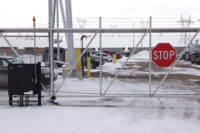ACCESS CONTROL
Wireless Access Control Tips & Tricks
Experts share their best access control advice for security dealers and integrators on selling and installing wireless access solutions.

The advancement of technologies like BLE now allows wireless locksets to offer real-time events, remote unlocking and frictionless entry with minimal effect on battery life, offering a much better experience. // IMAGE COURTESY OF PAXTON ACCESS
Wireless access control just keeps getting better. Innovation in readers and transmission technologies has fostered enhanced reliability, signal strength and connectivity — making it a flexible option for door control that’s affordable, easy to install and available in configurations for any entrance.
“Technology around wireless locks and readers has greatly improved and there are a variety of options available,” says Matt Welty, vice president, Americas at Codelocks Inc., Rancho Cucamonga, Calif. “Integrators need to continuously educate themselves on products and technologies in the market. Many times, they get complacent and offer the same products, regardless of the application,” Welty says.
“As each lockset requires a license for inclusion in the site’s access control system, integrators can significantly boost RMR. It may even be worth reducing margins to win such jobs, as the long-term payoff of securing more doors makes a lower upfront profit.” — Brach Bengtzen, ProdataKey
Battery life is another important consideration in wireless locksets, which has led to solutions either requiring numerous batteries or restricting functionality to preserve battery life, according to Steve Rowlands, divisional director of product management, Paxton Access, Greenville, S.C. “The advancement of technologies such as Bluetooth Low Energy (BLE) now allows wireless locksets to offer real-time events, remote unlocking and frictionless entry with minimal effect on battery life, offering a much better experience,” Rowlands says.
For systems integrators, wireless access control offers the opportunity to bring detection and protection to more doors — with less time and labor required for installation, lowering job costs substantially. Best of all, there’s an RMR component possible with remote monitoring and management service contracts.

Some top manufacturers offered their advice on selling, installing and maintaining wireless locks as well as any pitfalls to watch for. Here’s what they said:
Selling Wireless
Welty adds that it’s imperative for security integrators to understand the needs of each application, as every wireless solution offers different benefits. “Ask the client about anticipated growth or expansion,” he says. “Are they currently using three doors but hope to expand to 300? Are there specific needs such as time-based access control that require electronic locking components, or will the installation integrate with video alarms? Obtain as much information as you can prior to deciding on the right solutions.”
Brach Bengtzen, director of marketing, ProdataKey, Draper, Utah, says that if an integrator favors selling a particular access control solution, they should find out which wireless lock systems integrate seamlessly and support those as well. Similarly, if a customer is already using an access control platform and is happy with it, choose wireless locks that work best with it. “The real benefit of selling wireless is the ability to create highly competitive quotes based on time and labor savings.
“When integrators install a big job like a multifamily residential property, labor will be much less with wireless lock systems because there’s no need to run wires to every door. If the project uses a standard lockset and door type throughout, integrators can also speed up their work by creating a template for the coring of each door,” Bengtzen adds.
Technology Forges New Markets
Technological improvements simplify high-density installations, Bengtzen says. “Integrators should actively promote the option to add wireless locks to non-traditional locations. Gym lockers, school lockers, apartment tenant storage and mail cubbies, warehouse shipping and receiving bins and medical cabinetry for securing drugs and supplies are all places to upsell systems. As each lockset requires a license for inclusion in the site’s access control system, integrators can significantly boost RMR. It may even be worth reducing margins to win such jobs, as the long-term payoff of securing more doors makes a lower upfront profit.”
David Ito, project manager, Camden Door Controls, Mississauga, Ontario, says a critical part of the sales process and achieving reliable installation performance comes from gathering details on the environment. “Be aware of maximum distances between RF devices and any RF obstruction from receiver to transmitters. Determine the frequency of use to calculate power consumption if batteries are used and calculate if the added RF hardware costs offset the alternative hardwired labor costs.”

“Think outside the box,” says Jacob LeRoy, senior sales and development manager, Cypress Integration Solutions, Lapeer, Mich. “It’s not always necessary or desirable to attach a wireless reader to a wall; they can also be portable, handheld devices used for a range of purposes. Readers and door hardware such as locks can also be connected wirelessly using wireless reader-extenders.”
Derek Coats, national systems/integration specialist, dormakaba puts it simply: “Get trained. Get certified. Understand what you are selling. Don’t sell something you don’t understand. This product category has changed a lot and continues to evolve. Reach out to product manufacturers and industry experts. All are here to help. As a bonus, much of this training is free.”
Installing Wireless
The security integrator should have a thorough knowledge of the product type being ordered, says Lester LaPierre, director of business development, ASSA ABLOY Opening Solutions America, New Haven, Conn. “There are several different platforms available for the locking solution, whether cylindrical, mortise or exit device. The starting point is knowing the head-end system and credential type needed. Many manufacturers have a guide or product configurator to assist in proper product selection. Manufacturer instructions should be followed completely to avoid any issues with installation,” LaPierre says.
“Get trained. Get certified. Understand what you are selling. Don’t sell something you don’t understand.” — Derek Coats, dormakaba
When making the move from mechanical to electrical, taking photos of existing hardware will assist in specifying the right lock for the opening and appropriate product for the location, according to Sarah Russell Melluso, wholesale sales consultant for New England and Metro New York, Allegion, Carmel, Ind., with global headquarters in Dublin, Ireland. “Don’t make any assumptions; the environment does matter. Understand what is going on in that environment and the impact on lock performance. For your first wireless job, do a shop installation so you can test the wireless and learn how it works before going out in the field. When you know how to properly connect wireless, it really eliminates a lot of jobsite problems,” Russell Melluso says.
Rowlands of Paxton Access says a complete check of the location prior to installation is a must. “Many areas can affect the smooth operation of a wireless lockset, including door closers, stops, hinges, alignment and friction. If you are retrofitting onto an existing lockset, it should be checked to ensure good working order. If in doubt, take pictures or videos prior and send them to the manufacturer for advice.”
Where wireless hubs are required, consider their location carefully, Rowlands adds. “Ideally, they should be in line of site of the wireless handle they are connected to and positioned away from sources of interference such as metallic objects or other RF products. When commissioning a new system, it’s advisable to temporarily position a hub to ensure a strong connection before finalizing the fitting and cabling.”
Maintaining Wireless
Be cognizant of the ideal environment for RF technology and communicate to the facility manager that its characteristics should not change after commissioning in order to maintain long-term reliability, adds Ito of Camden Door Controls. “Any future partition walls or metallized filmed walls obstructing the line of sight may interfere with reliable operation. Regularly scheduled maintenance and scheduled replacement of batteries will prevent any system failures.”
Russell Melluso says most wireless products can be remotely monitored, so integrators know the current status of the lock. “Make sure the access control software platform has all wireless alarms enabled. If the batteries are running low, you’ll get a notification. If a key was used to enter, you’ll get a key override notification.”

Proper maintenance also includes evaluating the overall health of the door, which can influence wireless signaling. “Maintain the opening like you would a mechanical opening,” she adds. “For example, check that the door is closing properly and consistently.”
dormakaba’s Eric Botz says battery selection is important to maintenance. “Avoid lithium batteries for wireless locks/readers. While they are a cost-effective alternative to alkaline batteries, lithium doesn’t track loss of battery power. Lithium can lose its charge length of time with each charge, which could translate to more frequent battery replacement.”
Looking for a reprint of this article?
From high-res PDFs to custom plaques, order your copy today!







